Deck 5: Integration
سؤال
سؤال
سؤال
سؤال
سؤال
سؤال
سؤال
سؤال
سؤال
سؤال
سؤال
سؤال
سؤال
سؤال
سؤال
سؤال
سؤال
سؤال
سؤال
سؤال
سؤال
سؤال
سؤال
سؤال
سؤال
سؤال
سؤال
سؤال
سؤال
سؤال
سؤال
سؤال
سؤال
سؤال
سؤال
سؤال
سؤال
سؤال
سؤال
سؤال
سؤال
سؤال
سؤال
سؤال
سؤال
سؤال
سؤال
سؤال
سؤال
سؤال
سؤال
سؤال
سؤال
سؤال
سؤال
سؤال
سؤال
سؤال
سؤال
سؤال
سؤال
سؤال
سؤال
سؤال
سؤال
سؤال
سؤال
سؤال
سؤال
سؤال
سؤال
سؤال
سؤال
سؤال
سؤال
سؤال
سؤال
سؤال
سؤال
سؤال

فتح الحزمة
قم بالتسجيل لفتح البطاقات في هذه المجموعة!
Unlock Deck
Unlock Deck
1/154
العب
ملء الشاشة (f)
Deck 5: Integration
1
Find the function  satisfying the given conditions.
satisfying the given conditions. 
A)
B)
C)
D)
 satisfying the given conditions.
satisfying the given conditions. 
A)

B)

C)

D)

C
2
Suppose that a car can accelerate from  mph to
mph to  mph in
mph in  seconds. Assuming a constant acceleration, find the acceleration (in miles per second squared) of the car and find the distance traveled by the car during the
seconds. Assuming a constant acceleration, find the acceleration (in miles per second squared) of the car and find the distance traveled by the car during the  seconds.
seconds.
A) Acceleration = m/s22; distance =
m/s22; distance =  miles
miles
B) Acceleration = m/s22; distance =
m/s22; distance =  miles
miles
C) Acceleration = m/s22; distance =
m/s22; distance =  miles
miles
D) Acceleration = m/s22; distance =
m/s22; distance =  miles
miles
 mph to
mph to  mph in
mph in  seconds. Assuming a constant acceleration, find the acceleration (in miles per second squared) of the car and find the distance traveled by the car during the
seconds. Assuming a constant acceleration, find the acceleration (in miles per second squared) of the car and find the distance traveled by the car during the  seconds.
seconds.A) Acceleration =
 m/s22; distance =
m/s22; distance =  miles
milesB) Acceleration =
 m/s22; distance =
m/s22; distance =  miles
milesC) Acceleration =
 m/s22; distance =
m/s22; distance =  miles
milesD) Acceleration =
 m/s22; distance =
m/s22; distance =  miles
milesC
3
Suppose that a car can come to rest from  mph in
mph in  seconds. Assuming a constant (negative) acceleration, find the acceleration (in miles per second squared) of the car and find the distance traveled by the car during the
seconds. Assuming a constant (negative) acceleration, find the acceleration (in miles per second squared) of the car and find the distance traveled by the car during the  seconds (i.e., the stopping distance).
seconds (i.e., the stopping distance).
A) Acceleration = m/s2; distance =
m/s2; distance =  miles
miles
B) Acceleration = m/s2; distance =
m/s2; distance =  miles
miles
C) Acceleration = m/s2; distance =
m/s2; distance =  miles
miles
D) Acceleration = m/s2; distance =
m/s2; distance =  miles
miles
 mph in
mph in  seconds. Assuming a constant (negative) acceleration, find the acceleration (in miles per second squared) of the car and find the distance traveled by the car during the
seconds. Assuming a constant (negative) acceleration, find the acceleration (in miles per second squared) of the car and find the distance traveled by the car during the  seconds (i.e., the stopping distance).
seconds (i.e., the stopping distance).A) Acceleration =
 m/s2; distance =
m/s2; distance =  miles
milesB) Acceleration =
 m/s2; distance =
m/s2; distance =  miles
milesC) Acceleration =
 m/s2; distance =
m/s2; distance =  miles
milesD) Acceleration =
 m/s2; distance =
m/s2; distance =  miles
milesB
4
Find the general antiderivative. 
A)
B)
C)
D)

A)

B)

C)

D)


فتح الحزمة
افتح القفل للوصول البطاقات البالغ عددها 154 في هذه المجموعة.
فتح الحزمة
k this deck
5
Find the function  satisfying the given conditions.
satisfying the given conditions. 
A)
B)
C)
D)
 satisfying the given conditions.
satisfying the given conditions. 
A)

B)

C)

D)


فتح الحزمة
افتح القفل للوصول البطاقات البالغ عددها 154 في هذه المجموعة.
فتح الحزمة
k this deck
6
Find all functions satisfying the given conditions. 
A)
B)
C)
D)

A)

B)

C)

D)


فتح الحزمة
افتح القفل للوصول البطاقات البالغ عددها 154 في هذه المجموعة.
فتح الحزمة
k this deck
7
Find the general antiderivative. 
A)
B)
C)
D)

A)

B)

C)

D)


فتح الحزمة
افتح القفل للوصول البطاقات البالغ عددها 154 في هذه المجموعة.
فتح الحزمة
k this deck
8
Find an antiderivative by reversing the chain rule, product rule or quotient rule. 
A)
B)
C)
D)

A)

B)

C)

D)


فتح الحزمة
افتح القفل للوصول البطاقات البالغ عددها 154 في هذه المجموعة.
فتح الحزمة
k this deck
9
Find the general antiderivative. 
A)
B)
C)
D)

A)

B)

C)

D)


فتح الحزمة
افتح القفل للوصول البطاقات البالغ عددها 154 في هذه المجموعة.
فتح الحزمة
k this deck
10
Determine the position function if the velocity function is  and the initial position is
and the initial position is  .
.
A)
B)
C)
D)
 and the initial position is
and the initial position is  .
.A)

B)

C)

D)


فتح الحزمة
افتح القفل للوصول البطاقات البالغ عددها 154 في هذه المجموعة.
فتح الحزمة
k this deck
11
Find an antiderivative by reversing the chain rule, product rule or quotient rule. 
A)
B)
C)
D)

A)

B)

C)

D)


فتح الحزمة
افتح القفل للوصول البطاقات البالغ عددها 154 في هذه المجموعة.
فتح الحزمة
k this deck
12
Sketch a graph of a function  corresponding to the given graph of
corresponding to the given graph of  .
. 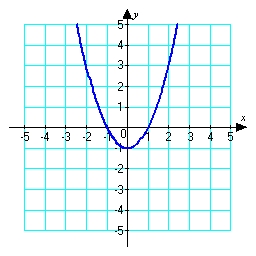

 corresponding to the given graph of
corresponding to the given graph of  .
. 


فتح الحزمة
افتح القفل للوصول البطاقات البالغ عددها 154 في هذه المجموعة.
فتح الحزمة
k this deck
13
Determine the position function if the acceleration function is  , the initial velocity is
, the initial velocity is  , and the initial position is
, and the initial position is  .
.
A)
B)
C)
D)
 , the initial velocity is
, the initial velocity is  , and the initial position is
, and the initial position is  .
.A)

B)

C)

D)


فتح الحزمة
افتح القفل للوصول البطاقات البالغ عددها 154 في هذه المجموعة.
فتح الحزمة
k this deck
14
Find all functions satisfying the given conditions. 
A)
B)
C)
D)

A)

B)

C)

D)


فتح الحزمة
افتح القفل للوصول البطاقات البالغ عددها 154 في هذه المجموعة.
فتح الحزمة
k this deck
15
Sketch a graph of a function  corresponding to the given graph of
corresponding to the given graph of  .
. 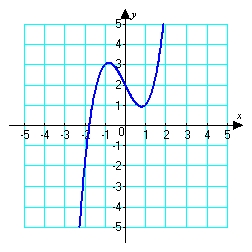
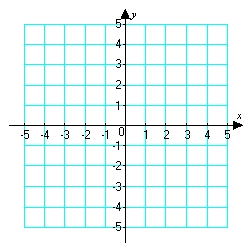
 corresponding to the given graph of
corresponding to the given graph of  .
. 


فتح الحزمة
افتح القفل للوصول البطاقات البالغ عددها 154 في هذه المجموعة.
فتح الحزمة
k this deck
16
The following table shows the velocity of a falling object at different times. For each time interval, estimate the distance fallen and the acceleration. Round to two decimal places. 


فتح الحزمة
افتح القفل للوصول البطاقات البالغ عددها 154 في هذه المجموعة.
فتح الحزمة
k this deck
17
Find an antiderivative by reversing the chain rule, product rule, or quotient rule. 


فتح الحزمة
افتح القفل للوصول البطاقات البالغ عددها 154 في هذه المجموعة.
فتح الحزمة
k this deck
18
Find the general antiderivative. 
A)
B)
C)
D)

A)

B)

C)

D)


فتح الحزمة
افتح القفل للوصول البطاقات البالغ عددها 154 في هذه المجموعة.
فتح الحزمة
k this deck
19
Find the general antiderivative. 
A)
B)
C)
D)

A)

B)

C)

D)


فتح الحزمة
افتح القفل للوصول البطاقات البالغ عددها 154 في هذه المجموعة.
فتح الحزمة
k this deck
20
Find the general antiderivative. 
A)
B)
C)
D)

A)

B)

C)

D)


فتح الحزمة
افتح القفل للوصول البطاقات البالغ عددها 154 في هذه المجموعة.
فتح الحزمة
k this deck
21
Translate into summation notation. 
A)
B)
C)
D)

A)

B)

C)

D)


فتح الحزمة
افتح القفل للوصول البطاقات البالغ عددها 154 في هذه المجموعة.
فتح الحزمة
k this deck
22
Use summation rules to compute the sum. 
A) 2264
B) 30,784
C) 39,964
D) 2804

A) 2264
B) 30,784
C) 39,964
D) 2804

فتح الحزمة
افتح القفل للوصول البطاقات البالغ عددها 154 في هذه المجموعة.
فتح الحزمة
k this deck
23
Use formulas to compute the sum. 
A)
B)
C)
D)

A)

B)

C)

D)


فتح الحزمة
افتح القفل للوصول البطاقات البالغ عددها 154 في هذه المجموعة.
فتح الحزمة
k this deck
24
Write out all terms and compute the sum. 
A)
B)
C)
D)

A)

B)

C)

D)


فتح الحزمة
افتح القفل للوصول البطاقات البالغ عددها 154 في هذه المجموعة.
فتح الحزمة
k this deck
25
Use summation rules to compute the sum. 
A)
B)
C)
D)

A)

B)

C)

D)


فتح الحزمة
افتح القفل للوصول البطاقات البالغ عددها 154 في هذه المجموعة.
فتح الحزمة
k this deck
26
Compute the sum and the limit of the sum as  .
. 
A) Sum = ; limit of sum as
; limit of sum as  is
is 
B) Sum = ; limit of sum as
; limit of sum as  is
is 

C) Sum = ; limit of sum as
; limit of sum as  is
is 
D) Sum = ; limit of sum as
; limit of sum as  is
is 

 .
. 
A) Sum =
 ; limit of sum as
; limit of sum as  is
is 
B) Sum =
 ; limit of sum as
; limit of sum as  is
is 

C) Sum =
 ; limit of sum as
; limit of sum as  is
is 
D) Sum =
 ; limit of sum as
; limit of sum as  is
is 


فتح الحزمة
افتح القفل للوصول البطاقات البالغ عددها 154 في هذه المجموعة.
فتح الحزمة
k this deck
27
Use mathematical induction to prove that  for all integers
for all integers  .
.
 for all integers
for all integers  .
.
فتح الحزمة
افتح القفل للوصول البطاقات البالغ عددها 154 في هذه المجموعة.
فتح الحزمة
k this deck
28
List the evaluation points corresponding to the midpoint of each subinterval, and evaluate the corresponding Riemann sum. Round the sum to two decimal places. 
A) Evaluation points:
Riemann sum:
B) Evaluation points:
Riemann sum:
C) Evaluation points:
Riemann sum:
D) Evaluation points:
Riemann sum:

A) Evaluation points:

Riemann sum:

B) Evaluation points:

Riemann sum:

C) Evaluation points:

Riemann sum:

D) Evaluation points:

Riemann sum:


فتح الحزمة
افتح القفل للوصول البطاقات البالغ عددها 154 في هذه المجموعة.
فتح الحزمة
k this deck
29
Use summation rules to compute the sum. 
A)
B)
C)
D)

A)

B)

C)

D)


فتح الحزمة
افتح القفل للوصول البطاقات البالغ عددها 154 في هذه المجموعة.
فتح الحزمة
k this deck
30
The following table shows the acceleration of a car moving in a straight line. If the car is traveling  ft/s at time
ft/s at time  , estimate the speed and distance traveled at each time.
, estimate the speed and distance traveled at each time. 
 ft/s at time
ft/s at time  , estimate the speed and distance traveled at each time.
, estimate the speed and distance traveled at each time. 

فتح الحزمة
افتح القفل للوصول البطاقات البالغ عددها 154 في هذه المجموعة.
فتح الحزمة
k this deck
31
Compute the sum and the limit of the sum as  .
. 
A) Sum = ; limit of sum as
; limit of sum as  is
is 

B) Sum = ; limit of sum as
; limit of sum as  is
is 

C) Sum = ; limit of sum as
; limit of sum as  is
is 

D) Sum = ; limit of sum as
; limit of sum as  is
is 

 .
. 
A) Sum =
 ; limit of sum as
; limit of sum as  is
is 

B) Sum =
 ; limit of sum as
; limit of sum as  is
is 

C) Sum =
 ; limit of sum as
; limit of sum as  is
is 

D) Sum =
 ; limit of sum as
; limit of sum as  is
is 


فتح الحزمة
افتح القفل للوصول البطاقات البالغ عددها 154 في هذه المجموعة.
فتح الحزمة
k this deck
32
Compute the sum of the form  for the given function and
for the given function and  -values, with
-values, with  equal to the difference in adjacent
equal to the difference in adjacent  's.
's.  ;
; 
A)
B)
C)
D)
 for the given function and
for the given function and  -values, with
-values, with  equal to the difference in adjacent
equal to the difference in adjacent  's.
's.  ;
; 
A)

B)

C)

D)


فتح الحزمة
افتح القفل للوصول البطاقات البالغ عددها 154 في هذه المجموعة.
فتح الحزمة
k this deck
33
Translate the following calculation into summation notation and then compute the sum. The sum of the squares of the first  positive integers.
positive integers.
A)
B)
C)
D) sum =
sum = 
 positive integers.
positive integers.A)

B)

C)

D)
 sum =
sum = 

فتح الحزمة
افتح القفل للوصول البطاقات البالغ عددها 154 في هذه المجموعة.
فتح الحزمة
k this deck
34
Write out all terms and compute the sum. 
A)
B)
C)
D)

A)

B)

C)

D)


فتح الحزمة
افتح القفل للوصول البطاقات البالغ عددها 154 في هذه المجموعة.
فتح الحزمة
k this deck
35
Use summation rules to compute the sum. 
A)
B)
C)
D)

A)

B)

C)

D)


فتح الحزمة
افتح القفل للوصول البطاقات البالغ عددها 154 في هذه المجموعة.
فتح الحزمة
k this deck
36
Translate the following calculation into summation notation and then compute the sum. Round to two decimal places. The square root of the sum of the first  positive integers.
positive integers.
A) sum =
sum = 
B) sum =
sum = 
C)

D)
 positive integers.
positive integers.A)
 sum =
sum = 
B)
 sum =
sum = 
C)


D)


فتح الحزمة
افتح القفل للوصول البطاقات البالغ عددها 154 في هذه المجموعة.
فتح الحزمة
k this deck
37
Suppose that a runner has velocity  mph for
mph for  minutes, velocity
minutes, velocity  mph for
mph for  minutes, velocity
minutes, velocity  mph for
mph for  minutes, and velocity
minutes, and velocity  mph for
mph for  minutes. Find the distance run. Round to two decimal places.
minutes. Find the distance run. Round to two decimal places.
A) miles
miles
B) miles
miles
C) miles
miles
D) miles
miles
 mph for
mph for  minutes, velocity
minutes, velocity  mph for
mph for  minutes, velocity
minutes, velocity  mph for
mph for  minutes, and velocity
minutes, and velocity  mph for
mph for  minutes. Find the distance run. Round to two decimal places.
minutes. Find the distance run. Round to two decimal places.A)
 miles
milesB)
 miles
milesC)
 miles
milesD)
 miles
miles
فتح الحزمة
افتح القفل للوصول البطاقات البالغ عددها 154 في هذه المجموعة.
فتح الحزمة
k this deck
38
Suppose that a car has velocity  mph for
mph for  hours, velocity
hours, velocity  mph for
mph for  hours, velocity
hours, velocity  mph for
mph for  minutes, and velocity
minutes, and velocity  mph for
mph for  hours. Find the distance traveled. Round to two decimal places.
hours. Find the distance traveled. Round to two decimal places.
A) miles
miles
B) miles
miles
C) miles
miles
D) miles
miles
 mph for
mph for  hours, velocity
hours, velocity  mph for
mph for  hours, velocity
hours, velocity  mph for
mph for  minutes, and velocity
minutes, and velocity  mph for
mph for  hours. Find the distance traveled. Round to two decimal places.
hours. Find the distance traveled. Round to two decimal places.A)
 miles
milesB)
 miles
milesC)
 miles
milesD)
 miles
miles
فتح الحزمة
افتح القفل للوصول البطاقات البالغ عددها 154 في هذه المجموعة.
فتح الحزمة
k this deck
39
The table shows the velocity of a projectile at various times. Estimate the distance traveled. Round to two decimal places. 


فتح الحزمة
افتح القفل للوصول البطاقات البالغ عددها 154 في هذه المجموعة.
فتح الحزمة
k this deck
40
Compute the sum of the form  for the given function and
for the given function and  -values, with
-values, with  equal to the difference in adjacent
equal to the difference in adjacent  's.
's.  ;
; 
A)
B)
C)
D)
 for the given function and
for the given function and  -values, with
-values, with  equal to the difference in adjacent
equal to the difference in adjacent  's.
's.  ;
; 
A)

B)

C)

D)


فتح الحزمة
افتح القفل للوصول البطاقات البالغ عددها 154 في هذه المجموعة.
فتح الحزمة
k this deck
41
List the evaluation points corresponding to the midpoint of each subinterval, sketch the function and corresponding approximating rectangles and evaluate the corresponding Riemann sum. Round the sum to two decimal places. 
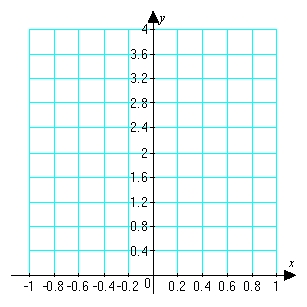



فتح الحزمة
افتح القفل للوصول البطاقات البالغ عددها 154 في هذه المجموعة.
فتح الحزمة
k this deck
42
Approximate the area under the curve on the given interval using  rectangles and left-endpoint evaluation. Round to three decimal places.
rectangles and left-endpoint evaluation. Round to three decimal places.  on
on  ,
, 
A)
B)
C)
D)
 rectangles and left-endpoint evaluation. Round to three decimal places.
rectangles and left-endpoint evaluation. Round to three decimal places.  on
on  ,
, 
A)

B)

C)

D)


فتح الحزمة
افتح القفل للوصول البطاقات البالغ عددها 154 في هذه المجموعة.
فتح الحزمة
k this deck
43
Evaluate the integral by computing the limit of Riemann sums. 
A)
B)
C)
D)

A)

B)

C)

D)


فتح الحزمة
افتح القفل للوصول البطاقات البالغ عددها 154 في هذه المجموعة.
فتح الحزمة
k this deck
44
Use the Midpoint Rule to estimate the value of the integral (obtain two digits of accuracy). 
A) 1.20
B)
C) 0.77
D) 0.43

A) 1.20
B)

C) 0.77
D) 0.43

فتح الحزمة
افتح القفل للوصول البطاقات البالغ عددها 154 في هذه المجموعة.
فتح الحزمة
k this deck
45
Approximate the area under the curve on the given interval using  rectangles and right-endpoint evaluation. Round to three decimal places.
rectangles and right-endpoint evaluation. Round to three decimal places.  on
on  ,
, 
A)
B)
C)
D)
 rectangles and right-endpoint evaluation. Round to three decimal places.
rectangles and right-endpoint evaluation. Round to three decimal places.  on
on  ,
, 
A)

B)

C)

D)


فتح الحزمة
افتح القفل للوصول البطاقات البالغ عددها 154 في هذه المجموعة.
فتح الحزمة
k this deck
46
Approximate the area under the curve on the given interval using  rectangles and right-endpoint evaluation. Round to three decimal places.
rectangles and right-endpoint evaluation. Round to three decimal places.  on
on  ,
, 
A) 58.704
B) 70.381
C) 63.000
D) 61.698
 rectangles and right-endpoint evaluation. Round to three decimal places.
rectangles and right-endpoint evaluation. Round to three decimal places.  on
on  ,
, 
A) 58.704
B) 70.381
C) 63.000
D) 61.698

فتح الحزمة
افتح القفل للوصول البطاقات البالغ عددها 154 في هذه المجموعة.
فتح الحزمة
k this deck
47
Use Riemann sums and a limit to compute the exact area under the curve.  on
on 
A)
B)
C)
D)
 on
on 
A)

B)

C)

D)


فتح الحزمة
افتح القفل للوصول البطاقات البالغ عددها 154 في هذه المجموعة.
فتح الحزمة
k this deck
48
Use the given function values to estimate the area under the curve using left-endpoint and right-endpoint evaluation. Round to two decimal places. 

A) Left-endpoint estimate is ; right-endpoint estimate is
; right-endpoint estimate is 
B) Left-endpoint estimate is ; right-endpoint estimate is
; right-endpoint estimate is 
C) Left-endpoint estimate is ; right-endpoint estimate is
; right-endpoint estimate is 
D) Left-endpoint estimate is ; right-endpoint estimate is
; right-endpoint estimate is 


A) Left-endpoint estimate is
 ; right-endpoint estimate is
; right-endpoint estimate is 
B) Left-endpoint estimate is
 ; right-endpoint estimate is
; right-endpoint estimate is 
C) Left-endpoint estimate is
 ; right-endpoint estimate is
; right-endpoint estimate is 
D) Left-endpoint estimate is
 ; right-endpoint estimate is
; right-endpoint estimate is 

فتح الحزمة
افتح القفل للوصول البطاقات البالغ عددها 154 في هذه المجموعة.
فتح الحزمة
k this deck
49
Use the Midpoint Rule to estimate the value of the integral (obtain two digits of accuracy). 
A)
B)
C)
D)

A)

B)

C)

D)


فتح الحزمة
افتح القفل للوصول البطاقات البالغ عددها 154 في هذه المجموعة.
فتح الحزمة
k this deck
50
Approximate the area under the curve on the given interval using  rectangles and midpoint evaluation. Round to three decimal places.
rectangles and midpoint evaluation. Round to three decimal places.  on
on  ,
, 
A)
B)
C)
D)
 rectangles and midpoint evaluation. Round to three decimal places.
rectangles and midpoint evaluation. Round to three decimal places.  on
on  ,
, 
A)

B)

C)

D)


فتح الحزمة
افتح القفل للوصول البطاقات البالغ عددها 154 في هذه المجموعة.
فتح الحزمة
k this deck
51
Write the given (signed) area as an integral or sum of integrals. The area above the  -axis and below
-axis and below 
A)
B)
C)
D)
 -axis and below
-axis and below 
A)

B)

C)

D)


فتح الحزمة
افتح القفل للوصول البطاقات البالغ عددها 154 في هذه المجموعة.
فتح الحزمة
k this deck
52
Approximate the area under the curve on the given interval using  rectangles and left-endpoint evaluation. Round to three decimal places.
rectangles and left-endpoint evaluation. Round to three decimal places.  on
on  ,
, 
A)
B)
C)
D)
 rectangles and left-endpoint evaluation. Round to three decimal places.
rectangles and left-endpoint evaluation. Round to three decimal places.  on
on  ,
, 
A)

B)

C)

D)


فتح الحزمة
افتح القفل للوصول البطاقات البالغ عددها 154 في هذه المجموعة.
فتح الحزمة
k this deck
53
Use Riemann sums and a limit to compute the exact area under the curve.  on
on 
 on
on 

فتح الحزمة
افتح القفل للوصول البطاقات البالغ عددها 154 في هذه المجموعة.
فتح الحزمة
k this deck
54
Evaluate the integral by computing the limit of Riemann sums. 
A)
B)
C)
D)

A)

B)

C)

D)


فتح الحزمة
افتح القفل للوصول البطاقات البالغ عددها 154 في هذه المجموعة.
فتح الحزمة
k this deck
55
List the evaluation points corresponding to the midpoint of each subinterval, and evaluate the corresponding Riemann sum. Round the sum to two decimal places. 
A) Evaluation points:
Riemann sum:
B) Evaluation points:
Riemann sum:
C) Evaluation points:
Riemann sum:
D) Evaluation points:
Riemann sum:

A) Evaluation points:

Riemann sum:

B) Evaluation points:

Riemann sum:

C) Evaluation points:

Riemann sum:

D) Evaluation points:

Riemann sum:


فتح الحزمة
افتح القفل للوصول البطاقات البالغ عددها 154 في هذه المجموعة.
فتح الحزمة
k this deck
56
Write the given (signed) area as an integral or sum of integrals. The area below the  -axis and above
-axis and above 
A)
B)
C)
D)
 -axis and above
-axis and above 
A)

B)

C)

D)


فتح الحزمة
افتح القفل للوصول البطاقات البالغ عددها 154 في هذه المجموعة.
فتح الحزمة
k this deck
57
Approximate the area under the curve on the given interval using  rectangles and midpoint evaluation. Round to three decimal places.
rectangles and midpoint evaluation. Round to three decimal places.  on
on  ,
, 
A) 1.000
B) 0.020
C) 0.750
D) 0.667
 rectangles and midpoint evaluation. Round to three decimal places.
rectangles and midpoint evaluation. Round to three decimal places.  on
on  ,
, 
A) 1.000
B) 0.020
C) 0.750
D) 0.667

فتح الحزمة
افتح القفل للوصول البطاقات البالغ عددها 154 في هذه المجموعة.
فتح الحزمة
k this deck
58
Give an area interpretation of the integral. 


فتح الحزمة
افتح القفل للوصول البطاقات البالغ عددها 154 في هذه المجموعة.
فتح الحزمة
k this deck
59
Use Riemann sums and a limit to compute the exact area under the curve.  on
on 
A)
B)
C)
D)
 on
on 
A)

B)

C)

D)


فتح الحزمة
افتح القفل للوصول البطاقات البالغ عددها 154 في هذه المجموعة.
فتح الحزمة
k this deck
60
Use Riemann sums and a limit to compute the exact area under the curve.  on
on 
 on
on 

فتح الحزمة
افتح القفل للوصول البطاقات البالغ عددها 154 في هذه المجموعة.
فتح الحزمة
k this deck
61
Use the Integral Mean Value Theorem to estimate the value of the integral. 


فتح الحزمة
افتح القفل للوصول البطاقات البالغ عددها 154 في هذه المجموعة.
فتح الحزمة
k this deck
62
Compute  , given
, given 
A)
B)
C)
D)
 , given
, given 
A)

B)

C)

D)


فتح الحزمة
افتح القفل للوصول البطاقات البالغ عددها 154 في هذه المجموعة.
فتح الحزمة
k this deck
63
Write the given (total) area as an integral or sum of integrals. The area between  and the
and the  -axis for
-axis for  .
.
A)
B)
C)
D)
 and the
and the  -axis for
-axis for  .
.A)

B)

C)

D)


فتح الحزمة
افتح القفل للوصول البطاقات البالغ عددها 154 في هذه المجموعة.
فتح الحزمة
k this deck
64
Suppose that, for a particular population of organisms, the birth rate is given by  organisms per month and the death rate is given by
organisms per month and the death rate is given by  organisms per month. Explain why
organisms per month. Explain why  represents the net change in population in the first 12 months. Determine for which values of
represents the net change in population in the first 12 months. Determine for which values of  it is true that
it is true that  . At which times is the population increasing? Decreasing? Determine the time at which the population reaches a maximum.
. At which times is the population increasing? Decreasing? Determine the time at which the population reaches a maximum.
 organisms per month and the death rate is given by
organisms per month and the death rate is given by  organisms per month. Explain why
organisms per month. Explain why  represents the net change in population in the first 12 months. Determine for which values of
represents the net change in population in the first 12 months. Determine for which values of  it is true that
it is true that  . At which times is the population increasing? Decreasing? Determine the time at which the population reaches a maximum.
. At which times is the population increasing? Decreasing? Determine the time at which the population reaches a maximum.
فتح الحزمة
افتح القفل للوصول البطاقات البالغ عددها 154 في هذه المجموعة.
فتح الحزمة
k this deck
65
Compute the average value of the function on the given interval. 
A)
B)
C)
D)

A)

B)

C)

D)


فتح الحزمة
افتح القفل للوصول البطاقات البالغ عددها 154 في هذه المجموعة.
فتح الحزمة
k this deck
66
Use the Integral Mean Value Theorem to estimate the value of the integral. 


فتح الحزمة
افتح القفل للوصول البطاقات البالغ عددها 154 في هذه المجموعة.
فتح الحزمة
k this deck
67
Use the graph to determine whether  is positive or negative.
is positive or negative. 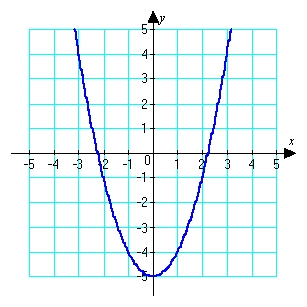
A) Positive
B) Negative
 is positive or negative.
is positive or negative. 
A) Positive
B) Negative

فتح الحزمة
افتح القفل للوصول البطاقات البالغ عددها 154 في هذه المجموعة.
فتح الحزمة
k this deck
68
Use Part I of the Fundamental Theorem of Calculus to compute the integral exactly. 
A)
B)
C)
D)


A)

B)

C)

D)



فتح الحزمة
افتح القفل للوصول البطاقات البالغ عددها 154 في هذه المجموعة.
فتح الحزمة
k this deck
69
Find a value of  that satisfies the conclusion of the Integral Mean Value Theorem.
that satisfies the conclusion of the Integral Mean Value Theorem. 
A)
B)
C)
D)
 that satisfies the conclusion of the Integral Mean Value Theorem.
that satisfies the conclusion of the Integral Mean Value Theorem. 
A)

B)

C)

D)


فتح الحزمة
افتح القفل للوصول البطاقات البالغ عددها 154 في هذه المجموعة.
فتح الحزمة
k this deck
70
Find a value of  that satisfies the conclusion of the Integral Mean Value Theorem.
that satisfies the conclusion of the Integral Mean Value Theorem. 
A)
B)

C)
D)
 that satisfies the conclusion of the Integral Mean Value Theorem.
that satisfies the conclusion of the Integral Mean Value Theorem. 
A)

B)


C)

D)


فتح الحزمة
افتح القفل للوصول البطاقات البالغ عددها 154 في هذه المجموعة.
فتح الحزمة
k this deck
71
Write the given (total) area as an integral or sum of integrals. The area between  and the
and the  -axis for
-axis for  .
.
A)
B)
C)
D)
 and the
and the  -axis for
-axis for  .
.A)

B)

C)

D)


فتح الحزمة
افتح القفل للوصول البطاقات البالغ عددها 154 في هذه المجموعة.
فتح الحزمة
k this deck
72
Write the expression as a single integral. 
A)
B)
C)
D)

A)

B)

C)

D)


فتح الحزمة
افتح القفل للوصول البطاقات البالغ عددها 154 في هذه المجموعة.
فتح الحزمة
k this deck
73
Write the expression as a single integral. 
A)
B)
C)
D)

A)

B)

C)

D)


فتح الحزمة
افتح القفل للوصول البطاقات البالغ عددها 154 في هذه المجموعة.
فتح الحزمة
k this deck
74
Use the graph to determine whether  is positive or negative.
is positive or negative. 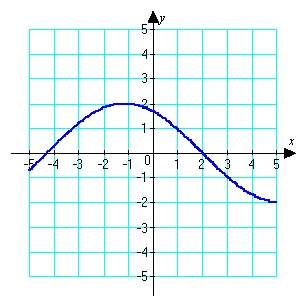
A) Positive
B) Negative
 is positive or negative.
is positive or negative. 
A) Positive
B) Negative

فتح الحزمة
افتح القفل للوصول البطاقات البالغ عددها 154 في هذه المجموعة.
فتح الحزمة
k this deck
75
Use the given velocity function and initial position to estimate the final position  . Round to two decimal places.
. Round to two decimal places. 
A)
B)
C)
D)
 . Round to two decimal places.
. Round to two decimal places. 
A)

B)

C)

D)


فتح الحزمة
افتح القفل للوصول البطاقات البالغ عددها 154 في هذه المجموعة.
فتح الحزمة
k this deck
76
Use the graph to determine whether  is positive or negative.
is positive or negative. 
A) Positive
B) Negative
 is positive or negative.
is positive or negative. 
A) Positive
B) Negative

فتح الحزمة
افتح القفل للوصول البطاقات البالغ عددها 154 في هذه المجموعة.
فتح الحزمة
k this deck
77
Use the given velocity function and initial position to estimate the final position  . Round to two decimal places.
. Round to two decimal places. 
A)
B)
C)
D)
 . Round to two decimal places.
. Round to two decimal places. 
A)

B)

C)

D)


فتح الحزمة
افتح القفل للوصول البطاقات البالغ عددها 154 في هذه المجموعة.
فتح الحزمة
k this deck
78
Compute the average value of the function on the given interval. 
A)
B)
C)
D)

A)

B)

C)

D)


فتح الحزمة
افتح القفل للوصول البطاقات البالغ عددها 154 في هذه المجموعة.
فتح الحزمة
k this deck
79
Sketch the area corresponding to the integral. 


فتح الحزمة
افتح القفل للوصول البطاقات البالغ عددها 154 في هذه المجموعة.
فتح الحزمة
k this deck
80
The impulse-momentum equation states the relationship between a force  applied to an object of mass
applied to an object of mass  and the resulting change in velocity
and the resulting change in velocity  of the object. The equation is
of the object. The equation is  , where
, where  . Suppose that the force of a golf club on a ball is approximately
. Suppose that the force of a golf club on a ball is approximately  thousand pounds for
thousand pounds for  between 0 and
between 0 and  seconds. Using
seconds. Using  slugs for the mass of a golf ball, estimate the change in velocity
slugs for the mass of a golf ball, estimate the change in velocity  (in ft/s). Round to 2 decimal places.
(in ft/s). Round to 2 decimal places.
A) ft/s
ft/s
B) ft/s
ft/s
C) ft/s
ft/s
D) ft/s
ft/s
 applied to an object of mass
applied to an object of mass  and the resulting change in velocity
and the resulting change in velocity  of the object. The equation is
of the object. The equation is  , where
, where  . Suppose that the force of a golf club on a ball is approximately
. Suppose that the force of a golf club on a ball is approximately  thousand pounds for
thousand pounds for  between 0 and
between 0 and  seconds. Using
seconds. Using  slugs for the mass of a golf ball, estimate the change in velocity
slugs for the mass of a golf ball, estimate the change in velocity  (in ft/s). Round to 2 decimal places.
(in ft/s). Round to 2 decimal places.A)
 ft/s
ft/sB)
 ft/s
ft/sC)
 ft/s
ft/sD)
 ft/s
ft/s
فتح الحزمة
افتح القفل للوصول البطاقات البالغ عددها 154 في هذه المجموعة.
فتح الحزمة
k this deck








